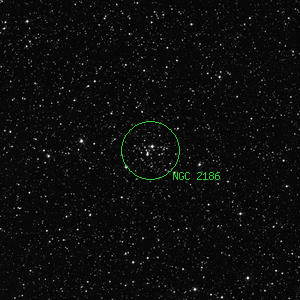NGC 2186

Overlaid DSS image of NGC 2186, 30' x 30' with north at top and west to the right
Aladin viewer for the region around NGC 2186
H VII 25, h 384, GC 1376, C 0609+054, OCl 498
| Type | Open Cluster |
|---|---|
| Magnitude | 8.7 |
| Size | 5.8' |
| Right Ascension | 6h 12' (2000) |
| Declination | 5° 27' N |
| Constellation | Orion |
| Description | Cl, pL, pRi, pC, st L and S |
| Classification | II 2 p |
Observing Notes
Andrew Cooper
Dec 12, 2021 Waikoloa, HI (map)
20cm f/6 Newtonian, Cave Astrola @ 136x
Seeing: 6 Transparency: 7 Moon: 0%
A pair of 10th magnitude stars surrounded by a faint glow, a bit more magnification resolves this glow into a cluster of faint 12-13th magnitude stars within 2' of the pair in a rich galactic starfield
Andrew Cooper
Dec 12, 2004 Sentinel, AZ (map)
46cm f/4.5 Deep Violet
Small, poor, about two dozen stars in a small clump, rich galactic star field
Captain William Henry Smyth
Jan 1, 1833 No. 6 The Crescent, Bedford, England (map)
150mm f/17.6 refractor by Tully 1827
A neat but minute double star, in a cluster, under Orion's left shoulder and in an outcropping of the Galaxy. A 9½ and B 10, both pale yellow. This is a tolerably rich and compressed mass of stars, from the 9th to the 16th magnitudes, with numerous stragglers. It was discovered by Herschel in 1786, and is No. 384 of his son's great Catalogue; but the reference in the latter to No. 2288 of the Double-star Sweeps, ought to have been 2301.
To fish up this object, pass a line from Rigel through the lower star of Orion's belt, and carry it a little more than as far again to the north- east, where it will strike the cluster at about 4° south-east of Betelgeuze.― A Cycle of Celestial Objects Vol II, The Bedford Catalogue, William Henry Smyth, 1844
Other Data Sources for NGC 2186
Nearby objects for NGC 2186
9 objects found within 120'
| 63 Orionis | 66 Orionis | Czernik25 |
| HD 42787 | HD 43511 | HD 43587 |
| NGC 2180 | NGC 2202 | PK204-8.1 |
Credits...
Drawings, descriptions, and CCD photos are copyright Andrew Cooper unless otherwise noted, no usage without permission.
A complete list of credits and sources can be found on the about page
NGC 2186